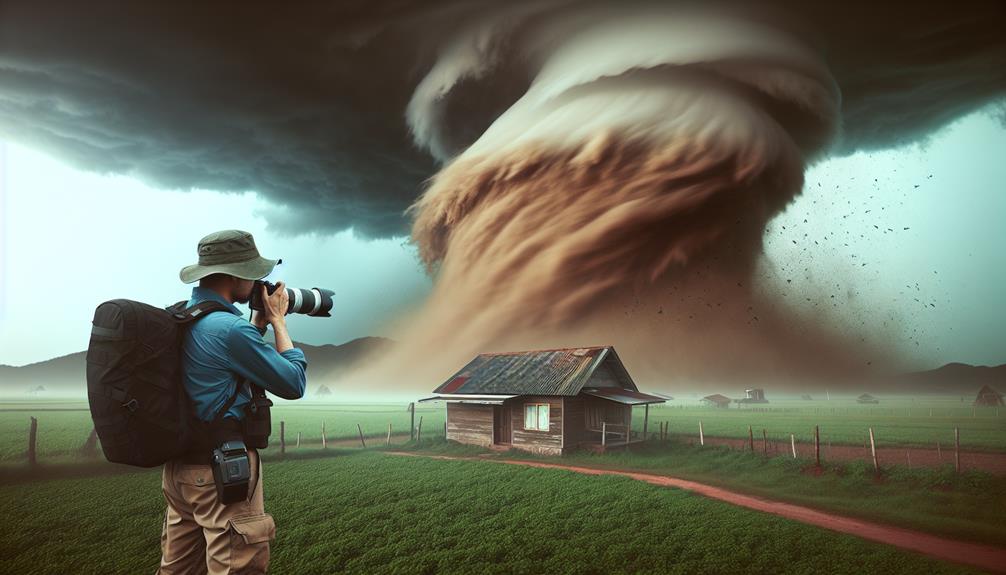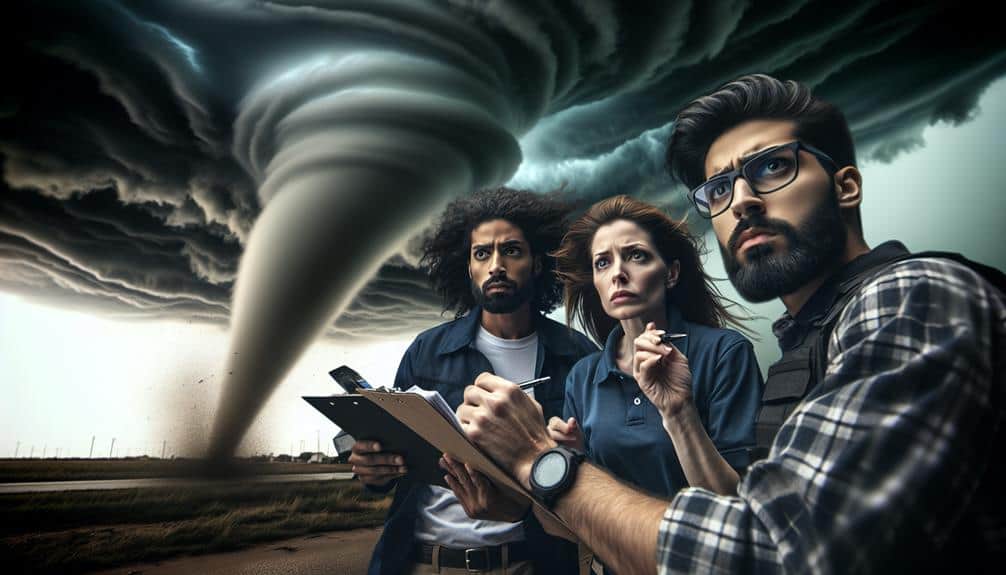As storm chasers, we must prioritize ethical conduct and proper etiquette. We always respect local communities by understanding their norms and minimizing our impact. Safety remains our top priority; we conduct thorough risk assessments and stay prepared with essential supplies. Protecting the environment is essential; we adopt eco-friendly practices and avoid disturbing wildlife. Data integrity is crucial; we verify sources and ensure accurate reporting. Additionally, we never trespass on private property and always seek consent before entering or capturing images. Through collaboration and clear communication, we maintain efficiency and safety. This inclusive guide will detail each aspect further for a responsible storm-chasing experience.
Key Points
- Always seek consent before entering private property to respect personal privacy and ethical standards.
- Prioritize safety by conducting detailed risk assessments and maintaining clear communication plans.
- Uphold data integrity by cross-referencing multiple reputable sources for accurate weather reporting.
- Show genuine respect for local communities by understanding and adhering to their customs and values.
Respecting Local Communities
When we venture into storm-affected areas, it's crucial that we respect the local communities by minimizing our impact and being mindful of their ongoing challenges. Cultural awareness is vital. We need to understand the customs and values of the communities we're entering. This means taking the time to learn about their cultural norms and showing genuine respect for their traditions and ways of life.
Community engagement is another key aspect. By interacting with local residents, we can gain valuable insights into how the storm has affected their daily lives. This isn't just about gathering data for our purposes but about creating a dialogue where we can offer support and show empathy. Small acts of kindness, such as helping with debris removal or providing supplies, can make a substantial difference.
Furthermore, we should always ask for permission before entering private properties and be transparent about our intentions. This builds trust and ensures that our presence isn't seen as an intrusion but rather as a collaborative effort to understand and document the storm's impact.
Prioritizing Safety First
Ensuring our safety is of utmost importance, and we must diligently follow established protocols to protect ourselves while in the field. First and foremost, emergency preparedness should be at the core of our planning. We need to have a thorough understanding of the risks involved and carry essential supplies.
A detailed risk assessment is vital before setting out, as it helps us anticipate potential dangers and make informed decisions.
To maintain safety, we should:
- Monitor weather conditions continuously: Using reliable sources guarantees we stay updated on storm developments and can adjust our plans accordingly.
- Establish communication plans: Regular check-ins with team members or base contacts aid in maintaining coordination and ensuring help is available if needed.
Environmental Conservation
As we prioritize our safety, we must also recognize our responsibility to minimize the environmental impact of our storm-chasing activities. It's crucial to adopt eco-friendly practices that support sustainable living. By doing so, we can enjoy our passion for storm-chasing while preserving the natural world.
First, wildlife preservation should be at the forefront of our efforts. When traversing diverse ecosystems, we must avoid disturbing habitats. Let's commit to keeping a respectful distance from wildlife and refrain from leaving any waste behind. Implementing recycling initiatives during our trips can greatly reduce our environmental footprint. Simple measures like carrying reusable containers and properly disposing of recyclable materials can make a big difference.
Moreover, we should consider the carbon emissions associated with our travel. Carpooling with fellow storm chasers and using fuel-efficient vehicles are practical steps toward sustainable living. We can also explore alternative energy sources, such as solar-powered equipment, to lessen our reliance on fossil fuels.
Lastly, let's engage in eco-friendly practices consistently. This includes supporting local conservation efforts and educating our peers about the importance of environmental stewardship. By integrating these strategies, we can chase storms responsibly and contribute positively to the planet.
Data Integrity and Accuracy
Let's guarantee our data integrity and accuracy by first verifying our data sources meticulously.
We must prioritize accurate weather reporting, as our safety and the quality of our research depend on it.
Real-time data sharing will enhance our ability to make informed decisions and adjust our strategies on the fly.
Verify Data Sources
Verifying the integrity and accuracy of data sources is essential for storm chasers to make informed, reliable decisions in the field. We need to guarantee that the data we rely on is both current and credible. Data verification from reliable sources is the cornerstone of our operations. When we fact-check and confirm the information accuracy, we minimize risks and enhance our ability to predict and respond to storm conditions effectively.
To maintain data integrity, we should:
- Cross-reference multiple sources: By comparing data from various reputable platforms, we can identify inconsistencies and validate the information.
- Check the credibility of the source: Rely on established meteorological organizations and avoid unverified or anecdotal reports.
Accurate Weather Reporting
Building on the importance of verifying data sources, we must also guarantee that our weather reporting is accurate, as this directly impacts our analysis and decision-making in storm-chasing scenarios. Accurate weather observation is the cornerstone of our mission. By meticulously gathering data, we assure that every storm we track is understood in its complexity.
Any lapse in data integrity could lead us into dangerous situations or, worse, disseminate incorrect information to the public.
We employ robust reporting techniques to maintain high standards. These include cross-referencing real-time data from multiple, reliable sources and utilizing advanced meteorological tools. We meticulously document each observation, ensuring that our reports aren't only precise but also actionable. This diligence helps us stay ahead of the storm and make informed decisions quickly.
Moreover, we must remain objective. Our passion for storm chasing should never cloud our judgment. Data must speak for itself, free from exaggeration or bias. By adhering to these principles, we uphold the credibility and trust essential to our community.
In the end, our commitment to accurate weather reporting empowers us to chase storms safely and effectively, embracing the freedom of our pursuit with responsibility.
Real-Time Data Sharing
Real-time data sharing is pivotal in guaranteeing data integrity and accuracy during storm-chasing operations. As storm chasers, we need to rely on the most current information to make informed decisions and keep ourselves and others safe. Sharing data in real-time allows for the immediate dissemination of critical updates, which can markedly impact the effectiveness of our efforts.
Live streaming: By broadcasting our observations live, we provide an unedited, real-time view of storm developments. This transparency helps maintain data integrity as viewers can see what we see, eliminating the need for delayed or altered information.
Social media sharing: Posting updates on platforms like Twitter and Facebook enables rapid communication with the public and fellow storm chasers. It guarantees that everyone involved receives the most up-to-date information, enhancing collective situational awareness.
Verification processes: Employing cross-verification methods, such as comparing our data with reports from other trusted sources, helps maintain accuracy. These checks and balances are essential for guaranteeing that the data we share is reliable.
Our commitment to accurate, real-time data sharing not only supports the broader meteorological community but also empowers individuals to make safer decisions during severe weather events.
Respecting Privacy Rights

As storm chasers, we must diligently honor the privacy rights of individuals whose property and lives we encounter during our pursuits. Public safety is our top priority, and respecting boundaries is a vital aspect of ensuring that safety. Trespassing on private property not only violates personal privacy rights but also poses significant risks to both us and the property owners. We must always seek consent before entering private lands or capturing images and videos of individuals and their properties.
Ethical journalism requires that we act with integrity and respect for those affected by severe weather events. When documenting the devastation caused by storms, it's crucial to take into account the emotional and physical toll on the victims. Acquiring explicit permission before sharing personal stories or images isn't only respectful but also aligns with ethical standards in journalism. By doing so, we demonstrate our commitment to responsible storm chasing and maintaining public trust.
Collaboration and Teamwork
When we chase storms, effective communication among team members guarantees everyone stays safe and informed.
We need to clearly define roles and responsibilities to streamline our operations and avoid confusion.
Communication Among Team Members
Effective communication among team members is essential for ensuring seamless collaboration and maximizing safety during storm chasing expeditions. To achieve this, we must establish clear communication channels that enhance team dynamics and guarantee all members are on the same page. When we're out in the field, every second counts, and any miscommunication can lead to dangerous situations.
- Consistent Updates: We should provide real-time updates about weather changes, road conditions, and any unforeseen obstacles. This keeps everyone informed and ready to adapt.
- Pre-Established Signals: Using predetermined signals or codes can help convey urgent information quickly, especially in noisy or high-stress environments.
Roles and Responsibilities
Assigning clear roles and responsibilities within the team is crucial for promoting efficient collaboration and maximizing our effectiveness during storm chasing expeditions. Each member needs to understand their specific duties to contribute meaningfully.
We designate roles such as navigator, driver, data analyst, and safety officer to enhance team coordination. The navigator plots our course, ensuring we're on the optimal path to intercept the storm. The driver focuses solely on operating the vehicle, allowing others to concentrate on their tasks.
Our data analyst interprets weather data in real-time, providing critical insights that shape our decisions. Meanwhile, the safety officer monitors conditions and ensures we maintain a safe distance from danger, ready to call for an evacuation if necessary. This structured approach minimizes confusion and optimizes our operational efficiency.
Community outreach is another essential responsibility. We liaise with local authorities to share real-time data, aiding in public safety efforts. By doing so, we contribute to the broader community, providing timely information that can save lives. Essentially, our roles aren't just about chasing storms but also about fostering a collaborative spirit and promoting safety within the communities we serve.
Frequently Asked Questions
What Equipment Do I Need to Start Storm Chasing?
We need a mountain of gear to start storm chasing! Essential items include a reliable vehicle, weather radar, GPS, and a sturdy camera. Don't forget safety precautions and mastering camera settings to capture the perfect shot.
How Can I Find Reliable Weather Updates While on the Road?
To find dependable weather updates on the road, we use weather apps and radar websites. We also rely on emergency alerts and local news sources for real-time data. This guarantees we stay informed and make safe decisions.
What Kind of Vehicle Is Best Suited for Storm Chasing?
What kind of vehicle guarantees our safety while providing enough room for emergency supplies? We need an SUV or truck with reinforced windows, ample storage, and off-road capabilities to handle unpredictable terrain and keep us prepared.
How Do I Join a Storm Chasing Tour or Group?
To join a storm chasing tour or group, we should research reputable companies online, ensuring they prioritize safety precautions. Engaging with the storm chasing community on forums and social media offers valuable support and helps verify their credibility.
Are There Any Legal Permits Required for Storm Chasing?
Oh, because getting a permit to chase tornadoes is every thrill-seeker's dream, right? We don't need legal permits, but we should follow safety precautions and local laws. Prioritize safety and respect boundaries while enjoying the freedom.


